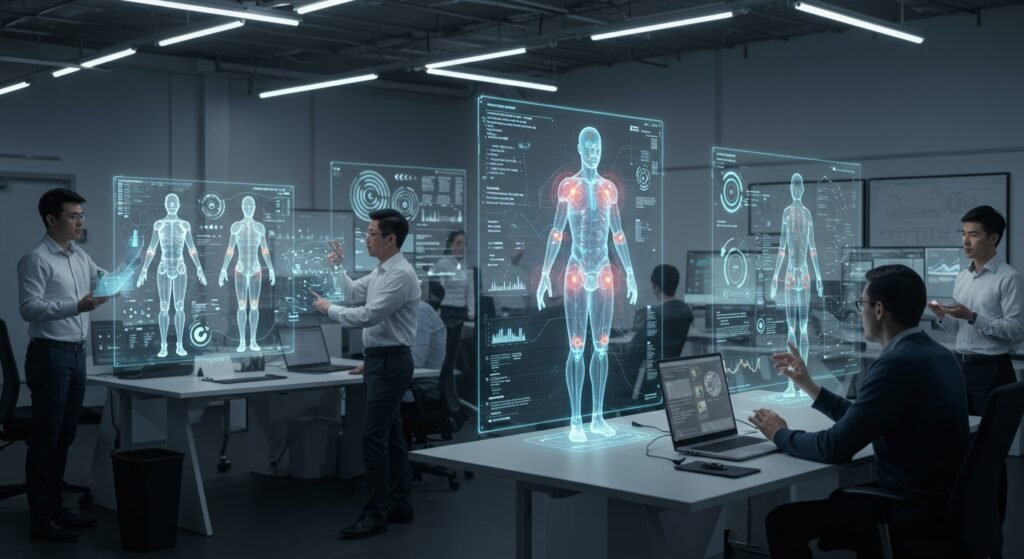Virtual Ergonomics and Digital Human Modeling Research
In an increasingly complex world where human-system interaction is paramount, the fields of virtual ergonomics and digital human modeling (DHM) research are revolutionizing how we design products, workplaces, and environments. Virtual ergonomics leverages advanced simulation technologies to analyze and optimize human performance, comfort, and safety without the need for physical prototypes. This cutting-edge approach allows engineers, designers, and researchers to predict and mitigate ergonomic risks early in the design process, leading to significant improvements in efficiency, health, and user experience across various industries.
Table of Contents
- What is Virtual Ergonomics? A Foundation for Innovation
- The Power of Digital Human Modeling (DHM)
- Applications of Virtual Ergonomics in Industry
- The Research Landscape: Current Trends and Challenges
- Future Outlook: Transforming Design with Virtual Ergonomics
What is Virtual Ergonomics? A Foundation for Innovation
At its core, virtual ergonomics is the application of virtual reality, simulation software, and human modeling techniques to assess and improve the ergonomic design of systems, products, and workspaces. Instead of relying on costly and time-consuming physical mock-ups, designers can use digital avatars, often based on anthropometric data, to simulate human interactions within a virtual environment. This allows for rapid iteration and testing of design concepts, from assembly line layouts to car interiors, identifying potential comfort issues, injury risks, or inefficiencies before any physical construction begins. The benefits are profound: reduced development costs, faster time to market, and ultimately, safer and more comfortable environments for users.
The Power of Digital Human Modeling (DHM)
Digital Human Modeling (DHM) is the backbone of virtual ergonomics. DHM tools enable the creation of highly realistic and customizable human models that can represent a wide range of human populations, including varying body sizes, ages, and physical capabilities. These digital avatars can then be placed into virtual environments to perform tasks, providing data on reach envelopes, vision fields, biomechanical loads, and cognitive interactions. This predictive capability is invaluable for optimizing designs for diverse user groups, ensuring inclusivity and accessibility.
Key Components of DHM
- Anthropometric Data: Databases of human body measurements for creating accurate models.
- Biomechanical Simulation: Tools to predict joint forces, muscle activity, and discomfort levels.
- Cognitive Modeling: Simulating human perception, decision-making, and workload.
- Postural Analysis: Assessing body postures for potential ergonomic risks and discomfort.
Applications of Virtual Ergonomics in Industry
The reach of virtual ergonomics extends across a multitude of sectors, offering transformative potential in each. Its ability to proactively address human factors has made it an indispensable tool for forward-thinking organizations.
| Industry | Key Virtual Ergonomics Application | Benefit |
|---|---|---|
| Manufacturing | Optimizing assembly line workflows, workstation design. | Reduced musculoskeletal disorders, increased productivity. |
| Automotive | Designing vehicle interiors, driver visibility, controls placement. | Enhanced driver comfort, improved safety, better user experience. |
| Aerospace | Cockpit layout, astronaut task analysis, maintenance access. | Improved operational efficiency, crew safety, reduced training costs. |
| Healthcare | Designing surgical tools, patient handling equipment, hospital room layouts. | Enhanced patient safety, reduced strain on medical staff, improved clinical outcomes. |
| Product Design | Ergonomic assessment of consumer goods (e.g., power tools, furniture). | Increased user comfort, reduced risk of injury, higher product satisfaction. |
The Research Landscape: Current Trends and Challenges
The field of virtual ergonomics is dynamic, with ongoing research pushing the boundaries of what’s possible. Current trends focus on integrating more sophisticated technologies and addressing complex human behaviors.
Advanced Simulation Techniques
Researchers are exploring the seamless integration of virtual and augmented reality (VR/AR) with DHM tools, allowing for immersive ergonomic assessments. This enables designers to “step into” a virtual workspace and interact with digital prototypes in a highly intuitive manner. Furthermore, artificial intelligence and machine learning are being employed to automate posture analysis, predict human behavior, and even generate optimal ergonomic designs based on complex datasets. This leads to more accurate and efficient analyses.
Overcoming Data Collection Hurdles
One of the persistent challenges lies in collecting sufficiently robust and diverse human data to train and validate these advanced models. Ethical considerations, data privacy, and the sheer variability of human physical and cognitive attributes require continuous innovation in data capture and modeling methodologies. Efforts are underway to develop more non-invasive sensing technologies and advanced statistical modeling techniques to address these challenges.
Future Outlook: Transforming Design with Virtual Ergonomics
The future of design is undeniably intertwined with the evolution of virtual ergonomics. We can anticipate even more personalized ergonomic solutions, where products and environments adapt to individual user needs in real-time. Predictive analytics, driven by AI and IoT, will allow for proactive ergonomic interventions, preventing discomfort or injury before it occurs. As our understanding of human factors deepens and computational power increases, virtual ergonomics will play an increasingly critical role in creating a safer, more efficient, and more human-centered world. For a deeper dive into foundational concepts, consider exploring Understanding Human Factors Engineering.
The continuous evolution in this domain promises to unlock significant value. For further academic insights, you might refer to publications by organizations like the Human Factors and Ergonomics Society, which often features pioneering research in this field.
In conclusion, virtual ergonomics, supported by digital human modeling, is not just a technological advancement; it’s a paradigm shift in how we approach human-centered design. By enabling comprehensive analysis and optimization in a virtual space, it empowers industries to create superior products and environments that genuinely prioritize human well-being and performance.


